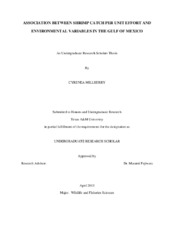ASSOCIATION BETWEEN SHRIMP CATCH PER UNIT EFFORT AND ENVIRONMENTAL VARIABLES IN THE GULF OF MEXICO
Abstract
The commercial shrimp harvest is the second most important fishery in the United States, and eighty percent of this harvest by weight is caught in the Gulf of Mexico (GOM). Survival rate in the post larval stage in GOM estuaries is hypothesized to be the most important in determining cohort strength. Previous research has shown that salinity and temperature changes in estuaries during peak recruitment affect shrimp growth, which can affect their survival. If environmental conditions such as tide and discharge affect these conditions and accordingly affect shrimp growth, then these environmental factors could be used as a proxy for estimating shrimp populations. Our analysis was performed to test the idea that shrimp abundance is significantly affected by tidal fluctuations and/or river discharge. Tide height data were obtained from 6 NOAA stations within the GOM, river discharge data were obtained from 7 major rivers, and SEAMAP brown shrimp (Farfantepenaeus aztecus) and white shrimp (Litopenaeus setiferus) catch per unit effort (CPUE) data were obtained from 10 statistical zones within the GOM. Two analysis methods, correlation analysis and partial least square regression analysis (PLSR), were performed between both environmental factors and shrimp data. Correlation analysis results showed consistently positive correlations between SEAMAP shrimp trawl data and tide data and consistently negative associations between SEAMAP shrimp trawl data and discharge data, both results are consistent with previous research. Results from both analytical methods indicate that the association between environmental variables and shrimp CPUE are small, but present and statistically significant, which is consistent with past research. Because PLSR analysis estimates effect size, these results can be viewed in terms of biological importance and used as a shrimp population management tool.
Subject
shrimpFarfantepenaeus aztecus
Litopenaeus setiferus
partial least square regression
Gulf of Mexico
Citation
Millberry, Cyrenea (2013). ASSOCIATION BETWEEN SHRIMP CATCH PER UNIT EFFORT AND ENVIRONMENTAL VARIABLES IN THE GULF OF MEXICO. Undergraduate Research Scholars Program. Available electronically from https : / /hdl .handle .net /1969 .1 /164410.


